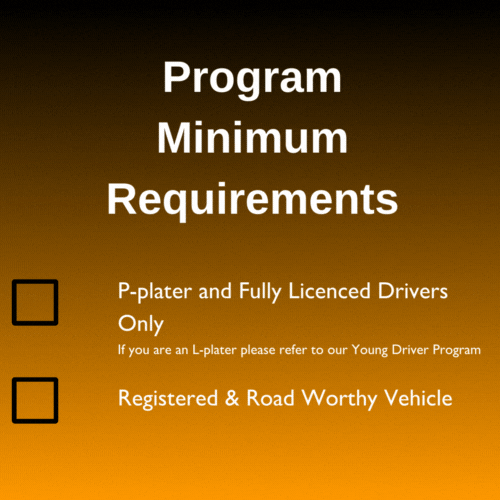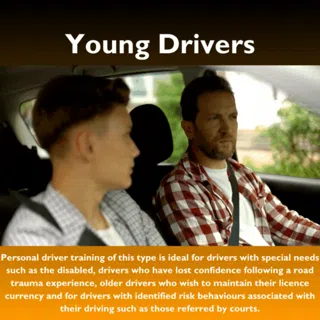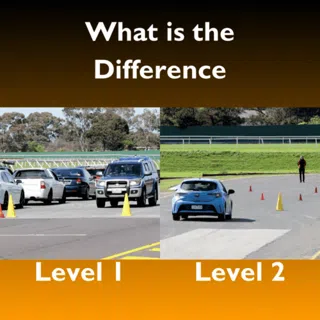FAQs
Program Questions
What are the minimum requirements to complete Defensive Driving Program Level 1 ?
1 - Hold a P-plate or Full licence for a motor vehicle.
2 - Have a registered and roadworthy vehicle.

What are the minimum requirements to complete Defensive Driving Program Level 2?
1 - Completed Level 1 with Murcotts Driving Excellence or have completed a similar program with another provider. (proof will be required at the time of booking)
2 - Hold a P-plate or Full licence for a motor vehicle.
3 - Have a registered and roadworthy vehicle.

Can an L-Plater complete Defensive Driving Programs Level 1 or Level 2?
No - L-Plater have to gain the Driving experience required to participate Level 1 or Level 2.
We do have a Young Driver Development Program suitable for L-Platers, which can be found under Driver Training Programs in the top bar.

Does Murcotts Driving Excellence supply a vehicle?
Murcotts does not supply vehicle for its Defensive Driving Programs.
To get the most out of a Murcotts program, using your own car or work vehicle is the most beneficial option as it is the vehicle you are most familiar with
Does the program still run if it is raining?
Yes, the program will go ahead as planned, unless you are contacted by one of our Murcotts staff to reschedule.
Please Note: Please dress appropriately and bring an umbrella.

How long after completing Level 1 can I book in for Level 2?
We recommend you wait at least one (1) month after completing Level 1 to book in for Level 2.
This will give time to put into practice what you have gained from the Level 1 Program.

What's the Difference between Defensive Driving programs Level 1 and Level 2 ?
DDP1 focuses on foundational defensive driving principles, including hazard detection, understanding emergency control limitations, and the LOOK UP. STAY BACK® technique. It covers vehicle safety checks, practical activities to understand reaction time and stopping distances, vehicle dynamics, and key road laws, with practical training conducted at suburban speeds.
On the other hand, DDP2 offers advanced driving tuition, assessing drivers' control usage, including gears, brakes, and steering. It includes maneuvers at freeway/highway speeds in a safe environment, discussions on risk-taking, slalom and cornering techniques, collision avoidance training, wet road driving (if permitted), revision of defensive systems, and issues certificates upon completion.

How long does the Level 1 and Level 2 programs run for?
Both the Level 1 and Level 2 training programs run from 8:30 am to 4:15 pm.
Please Note - The start time is 8:30 am sharp. This will ensure you do not miss any important information prior to the program commencing.
General
Does Driver Training Work?
This question never arises for pilot training. It goes without saying that passengers would not fly if pilots had the limited training drivers receive before licensing. Thankfully pilots are also required to undertake regular refresher training and testing.
The problem is that a person can be given a driver licence without having untaken any formal instruction or training. The licence test, which takes about 40 minutes, mainly targets road law rather than driving capability in all conditions. Once licensed, drivers can drive forever without further training. It is simply left to chance that drivers will learn from experience as they drive but most will crash at least once and some crashes will be fatal. Not a good model for pilots!
Drivers and operators of all dangerous machinery need to continue their learning throughout their driving or operating careers. Short driver training courses can be of great benefit as a refresher and stimulus to that learning. Drivers who attend accredited post licence courses such as Defensive Driver Training, often express surprise when they discover what they don't know or what they have forgotten, including common road laws.
It is interesting to note that people who take up other skilful activities such as swimming, golf, playing a musical instrument or scuba diving, for example, do not expect to master the skills in a one-off training course.
Does driver training work? Well that depends on the quality of the training, the learning outcomes being targeted, the credentials of the trainers and most importantly, the motivation of the driver to change their old way of driving to the new way.
Does the Government support driver training?
All governments support initial training for learners but the glaring gap in government road safety strategies is the lack of ongoing post licence training.
The crash and death rate for newly licensed drivers ought to be reason enough to do something but governments are wary of training.
One likely reason is cost. Whereas other road safety initiatives such as speed enforcement are revenue generating, training may impose a cost burden.
There are political ramifications as well. Most drivers consider themselves above average so if governments started forcing them to improve their driving by attending a course, many drivers would be resistant, even offended.
Governments face an interesting dilemma though. Occupational health and safety legislation requires employers to provide training particularly vehicle familiarisation training yet there is no requirement for governments to promote this to the public.
Why are there concerns about skills-based driver training?
The terms “skills-based” or “traditional” driver training have created considerable confusion and uninformed debate within the road safety industry. Skills-based training has been loosely used to describe training that focuses solely on vehicle control skills particularly to deal with emergencies such as skid control.
Accredited driver training providers like Murcotts have acknowledged this research and skid control training is not used in defensive driving programs. However learning what causes skids and how to avoid them is crucial for crash avoidance.
What is missed by those who use the term "skills-based" to denergrate driver training, is the fact that they show their ignorance about safe driving which is absolutely dependent on driver skills such as scanning for hazards, assessing risky situations, decision making about appropriate speed, managing emotions, avoiding distractions, making allowances for other road users, ensuring their vehicle is in a safe condition - the psychological or cognitive skills.
In industries where the application of safe skills is crucial, there is no debate about skills-based training. But some road safety advocates and government officials choose to confuse the issue and deny the available facts and this is partly due to the lack of credible research especially in Australia. Murcotts' training is based on the evidence that is available from safe behaviour modification programs and research in other fields such as aviation safety.
If racing car drivers are so skilled, why do they have so many crashes on our roads?
First of all, racing drivers are not all highly skilled. Like in any sport, those who engage usually cover the whole spectrum of capability.
Research conducted many years ago in America showed racing drivers had higher crash rates than the general public. The research was inadequate because it assumed that the skills used in motor racing are the same for general road traffic situations. Further the research assumed a level of skill on the basis that the racing drivers had a competition licence and it failed to isolate a likely characteristic of racing drivers being higher risk takers — a key factor in road crash causation.
This research is used as a manipulative argument often quoted by persons with vested interests, and indicates a wowser approach.
Motor racing has provided massive safety improvements for the general motoring public and most drivers would do well to copy the defensive skills of competent top-level racing drivers. These drivers have perfected the skills of anticipation, looking up ahead and reading the situation allowing them to change their driving to stay out of trouble.
Additionally they don’t drink and drive when racing, they are very fit and alert and they concentrate.
I have a driving licence, so why would I want to do further driver training?
For most drivers, the training that occurred before obtaining a licence focused on passing a test in basic car control techniques and road law.
The very high crash and death rate for newly licensed drivers is evidence that this training and the test itself, is inadequate. However, as a driver’s experience on the road increases their crash rate usually decreases provided they survive.
Undertaking Defensive Driver training programs can help drivers to learn safe driving strategies in a planned way rather than relying on experience alone.
Can better driving be achieved in one day?
As with any training there is a limit to what can be achieved in short courses. Improving your driving is a continuous learning process.
Our basic Defensive Driving Program has been operating since 1969 and has continually developed in response to research and changing vehicle and safety technology.
People tell us that they have learnt more in one day than they have in 20 years of driving. Murcotts offer a range of programs and refresher training should occur to ensure drivers keep up to date with the latest information. We could run courses for weeks but most drivers have neither the time nor the desire to do that.
Don’t these programs give drivers, especially young drivers, too much confidence?
Generally all drivers are optimistic about their driving ability. This is more so with young drivers. Defensive driving can help them to gain a more realistic view of their ability and to recognise the risk taking behaviours that may lead to crashes.
Our programs address the five human elements that make up our driving profile: Behaviour, Attitude, Awareness, Motivation and Skill. We call it our BAAMS® driver profile and through practical learning exercises, drivers realise their limitations.
Aren’t these programs run by motor racing drivers?
It is not surprising that some drivers who have an intense interest in driving in all its forms become driver trainers. Murcotts trainers have driver training qualifications and backgrounds arising from their experience in police, ambulance and military employment and have appropriate and recognised licenses for the program they are teaching.
As a minimum qualification, Murcotts trainers are required to have Certificate IV in Driving Instruction and Certificate IV in Assessment and Workplace Training. Murcotts also have trainers with specialist occupational health and safety and crash investigation skills.
Why do these programs run at race tracks?
Motor racing circuits are just some of the venues used for Defensive Driving Programs because they have the facilities we require, for instance tutorial rooms and safe road surfaces that can be divided into appropriate driving activity areas.
As Murcotts is a national organisation, we use venues in regional and rural areas across Australia ranging from car parks, air strips, military parade grounds and dedicated driver training facilities. All do the job just as well because genuine defensive driving programs do not involve undertaking high speed work or hot laps of racing circuits.
Murcotts also conduct RoadCraft programs on-road in normal traffic for assessment and coaching purposes.
Of great concern is the fact that some providers undertake driver training activities, such as emergency braking, on public roads. This is highly dangerous for other road users, if not illegal. These providers attempt to distinguish themselves by advocating against off-road courses.
Can’t anybody set up a Driving School?
Yes, they can. That is why you should be particular and do your homework on which driver training course you attend. The driver training industry is largely unregulated but the leading providers require certain qualifications and standards.
Choose a provider that can prove their credentials as an accredited Registered Training Organisation and that their staff have a broad qualification base beyond driving instruction.
Can I Attend a Driving Course While Pregnant?
Attending a driver training course that is properly designed to improve your safe driving behaviour and reduce risks while driving, should not be a risky endeavour just because you are pregnant.
In fact, not learning about how to avoid emergency situations and crashes may place you and your unborn child at a greater risk if you drive vehicles.
The following are some basic guidelines:
1. Your safety and well-being overrides everything else – if you have any concerns while pregnant, then you need to seek your Doctor’s advice before driving or attending a driving course.
2. Seat Belt - if you are pregnant and you drive or you are a passenger, it is essential that you correctly wear a seatbelt at all times. In a crash or emergency braking situation, a poorly fitted seatbelt may be the cause of injury to both you and your unborn baby. Make sure the lap section of your seatbelt fits firmly across the bony section of your hips and below your abdomen. The shoulder section of the belt should cross your sternum to provide upper-body restraint preventing you from being thrust forward in an emergency.
3. Correct Seating - in the event of a crash or emergency braking situation, you need the maximum distance between your abdomen and the steering wheel in case the airbag deploys. You may need to move your seat back to achieve a gap of at least 25 centimetres between the steering wheel and your breastbone. This may need to increase as your pregnancy progresses but there may be a limit to this movement and your ability to control your vehicle safely. If your vehicle has height and telescopic adjustable steering, use this to help maintain the optimum safe seating set up.
4. You are in control – at all times whilst attending a Murcotts’ course, you need to be comfortable. Sometimes you will be seated in the training room or undertaking driving activities and at times you will be outdoors, standing and observing others. If at any time you are concerned or feeling uncomfortable, please talk to your trainer. You can choose not to take part in a particular activity – observing and listening to the trainer will suffice in covering your learning.
The practical exercises you will undertake in the driver training course simulate real driving scenarios and are no more strenuous than those you may encounter in everyday driving.
If you would like more information call us on 1300 555 576.

Follow Us
1300 555 576
Sandown International Motor Raceway
Training Room 2
591–659 Princes Highway
Springvale VIC 3171
Office Hours
Monday-Friday: 9 am – 5 pm
Registered Training Organisation: RTO # 45521 | training.gov.au
© Copyright 2025. Murcotts Driving Excellence. All rights reserved.
